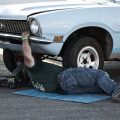Pre-delivery checks can be an important part of each day for a commercial driver getting ready for a stint on the open road. In addition to taking a look at parts of the vehicle’s exterior, in-cab checks to make sure things are working both properly and safely are things to do before starting that engine. Here are just four of the cab checks to run before every delivery drive you might take.
Oil Pressure
Proper oil pressure is a factor that contributes to the overall longevity of your truck’s engine, and it is one of the things that can help you make sure that things are running smoothly. Check the oil pressure gauge in your cab before each delivery. If that gauge reads too high, it could be a sign that you have the wrong type of oil running through the system or a blocked filter. A low reading means there might be a broken pump or stripped bearing.
Lights
A delivery truck’s headlamps need to be in proper working order before each drive. Even in ideal weather conditions without obstructions such as rain or fog, things like a Scania left-hand headlamp can provide additional illumination that increases the visibility of the road and the surroundings when a driver is on the road. If a driver needs to deliver parcels at night, working headlamps are essential for safety. In addition to testing front lights for any faults, drivers should also check dash indicators for turn signals and emergency lights during this in-cab inspection.
Wipers and Washers
A truck’s wipers are the first line of defense against rain, sleet, snow, or general debris that might pile up on the windshield and obstruct visibility. All drivers should make an in-cab check of the wipers before each delivery. A driver can activate the wipers to make sure the arms move properly at various speed settings. In addition to making sure the arms are operational, drivers should do a spot check to make sure they are attached correctly and undamaged. If the vehicle includes washers, a driver can activate them briefly for inspection.
Brakes
Making sure that the brake pedal operates correctly is part of a cab check, but there are a few other steps that go with this procedure. Drivers can make sure any brake light indicators are working correctly when the pedal is down. In addition, they should get check adjustment indicators for proper positioning.
Running cab checks is not usually difficult or time-consuming. Drivers taking the time to go through these procedures properly can put the finishing touches on the safety and readiness of their vehicles when it is time to make these spaces a bit of a home away from home.
































No Comments
Leave a comment Cancel